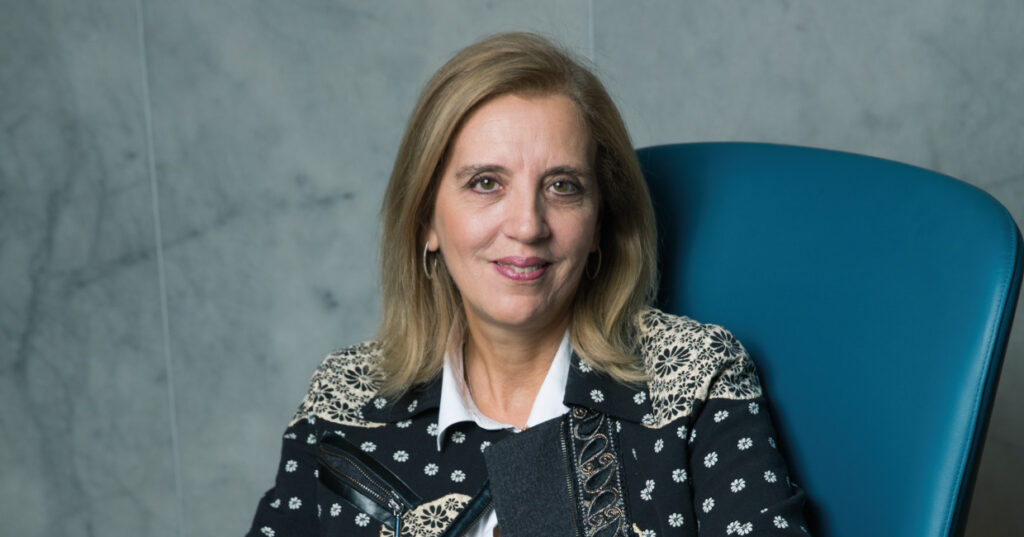Speaking frankly about what makes a guest experience special, Founder and Managing Director of MKV Design, Maria Vafiadis, tells Sophie Harper why she’s relieved hotels have finally caught on to the idea of giving guests a proper sense of place.
Maria Vafiadis founded MKV Design in 2000 following an architectural career in Greece and then Vienna, before moving to the UK where she worked for a studio specialising in hotel design for almost a decade. Launching her own studio as a one-woman-wonder, MKV Design soon grew and is now a studio of more than twenty designers and architects. “I’ve always travelled,” Maria tells me as we sit either side of the huge table in her London studio board room. “I left Greece when I was very young, I studied abroad in Italy, I’ve lived in different countries – and although my DNA is Greek I consider myself very international.” She puts emphasis on her love for world travel and says, “I think when you live in another country you open yourself up to different cultures.”
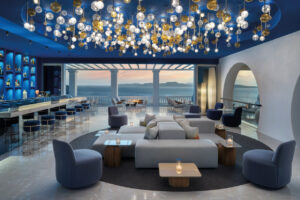
Maria was born and raised in Athens, but rather than take a traditional route into medicine or engineering she decided to study architecture and moved to Milan to do so. “It is a beautiful city, it really opened my horizons and I was really influenced by Italy and its aesthetics.”
Her early career focused largely on residential architecture, but when Maria moved to Vienna she worked on commercial projects and realised she enjoyed hotel design before then choosing that industry to specialise in in the UK. “When you are a hotel designer, you are spoiled. Hotel design flows in a better way. With residential projects, there can be a lot of changes and so you have to put yourself in a different frame of mind.”
A headstrong woman with plenty of opinions, Maria is very animated when she talks about things she feels passionately about. She tells me why she finds hotel experiences magical and that she is often bitterly disappointed when a hotel doesn’t place enough importance on sense of place and therefore lacks connection to the local culture. “It’s so much more interesting when a hotel can say, this food is from the local farm, and then offers to show you where the local farm is so you can visit and see for yourself, talk to the farmer. That’s real, that’s not staged,” she says. “When there is a show of chefs cooking in front of the guests, this is a stage, it’s not real,” she gestures with her hands in a chopping motion. “Whereas you could visit the local farm and see the family working, see grandma sitting there making dolmas – that’s the real thing.”
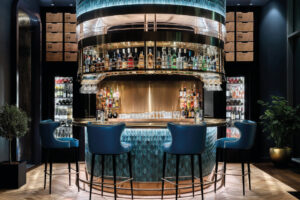
She speaks about the differences she’s seen in the industry since she started working on hotel projects and expresses her relief at the shift away from mass-production. “We have to get away from the industrialisation of tourism and create unique experiences for everyone, this is what hotels are trying to do in different ways – they’re trying to get away from these stereotypical packages in different aspects. Guest don’t want to simply see or observe, they want to feel a connection and interact with their locality. This is very important to us when we design a hotel.”
Maria tells me how MKV approaches each project and says that research is key. “Depending on the location, we look at what each place is well-known for – or conversely, what it is not well-known for. It’s surprising what information you can find on the internet, we might discover that an artist comes from a particular city, or that a book was written about this place, or find the history fascinating. There isn’t a checklist, sometimes it’s just what comes up. It’s a starting point to build on.”
Maria explains that MKV takes a lot of influence from the property itself and that she finds heritage buildings particularly interesting. “If it’s a building with history then that’s a great opportunity, which I love, because from the surface you keep discovering things. If it isn’t and the building is new, then the locality offers you everything.”
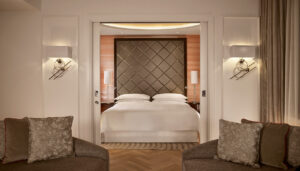
Recalling a conversation with a friend she had some years ago, Maria reflects on the reasons she so staunchly believes in not having a specific ‘look’. “An American friend criticised me once for this, because he said ‘Maria, I can’t see your brand’ – and I said, ‘you know what, that is the best compliment for me’,” she explains that she has never wanted to attract just one profile of client with a set profile of projects. “That was maybe 15 years ago, when branding was very different – it was very visual, but now it’s more to do with experience and interaction. There’s much more freedom now, which is great, each designer has their own DNA but it’s important to make each project feel unique. Plus, if we did the same thing over and over again, we’d quickly become very bored. I’m sure there are people happy to do the same thing day in, day out, but that’s not us.”
With a big portfolio of residential as well as hospitality projects to the studio’s name, Maria tells me she likes the mix of working across the two and that they’re working on some exciting high-end projects in Abu Dhabi as well as the Ellinikon project in Greece. She describes how often she is inspired by residential projects or elements that would translate and work within a hospitality setting. “We might extract something and simplify it for a hotel project, or we might work it into the presidential suite – there are definitely synergies.”
She talks about other MKV projects that have left a particular impression on her and speaks enthusiastically about Bürgenstock Hotels & Resort in the Swiss Alps. “It seems that every ten years we get a mega project, which is good for us. We work quite a lot with Katara Hospitality in Switzerland. The Bürgenstock Resort is the flagship. In the 1960s it was the place to go – Sophia Loren had a home there, all the big names were there, Audrey Hepburn was married there, it’s an amazing place, and we’re so lucky to have worked there.”
The resort is vast, comprising a number of separate buildings. “There used to be the old Palace Hotel, which has had to stay because it is a heritage building, so we refurbished that, then there was another hotel, The Park Hotel, that was built in the 80s or 90s that they were allowed to pull down to build the new Bürgenstock Hotel,” Maria explains.
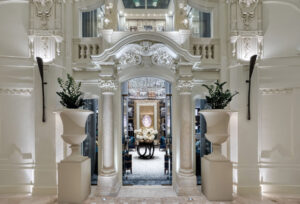
“It’s designed in a way that everything is about the views – everything. It’s up in the mountains – it’s not a ski resort but it is in the mountains, and from there you have the most breath-taking views of Lake Lucerne. It is at the height where the clouds form – so some days you can be there and not see anything outside other than clouds – it’s very different, unique. One of the most striking things about the rooms is the bathtubs looking out over the view, but you’re not exposed, only the birds can see you! It’s very special.”
She goes on to explain how the restaurant is cantilevered over the mountain, and then separate to that, the spa, which MKV also worked on, is around 10,000 square metres – which might just be the biggest spa in Europe. “I love a challenge,” she says, “and often with these huge projects you have so many different elements, you have to work out how everything will come together without just looking the same.”
Maria tells me that being mindful of the demolition that was involved in the creation of the new hotel, her and her team found opportunities to reuse as many materials as possible. “Katara was very clever at keeping everything – they had a big shed in the forest that was like no place on Earth, you could go in and pick out different things to reupholster or refurbish. We came up with different formations to use the Murano glass from the old Park Hotel chandeliers into new ones for The Palace Hotel and actually we’ve used almost every piece of furniture and given it a new lease of life. We try to do that with all our projects, repurpose things that are already available to us. It is a conscious decision.”
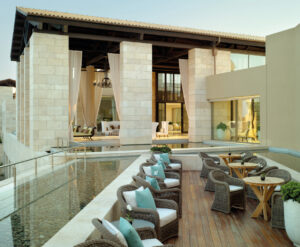
Maria explains that this is not only a sustainable decision, but also has financial implications where reusing materials is a much more cost-effective way to keep to a budget. “Rather than ripping out a marble floor, for example, I will ask a client if they are prepared for the cost of replacing it with something as appropriate and with the same level of longevity. If they really don’t like it that much, we can put a rug over the top! We try to work around these things. Often materials, furniture, has history attached to it as well, and that’s what we try to preserve. If I can use it, I won’t throw it away.”
Currently, MKV has a number of projects on the go in Spain, Bulgaria, Switzerland, and Greece. “We are working on the Presidential Villas at the Mandarin Oriental in Navarino, then we have two projects in Crete, and a resort in the north of Greece.” I ask her if she enjoys going back to Greece to work on projects in her home country. “Yes, of course,” she says, “I really enjoy working on Greek projects, it’s my country. For a while there weren’t many projects happening in Greece, but now it’s booming! But I like the variety of working all over the world and bringing something different to each project, making an experience for the guest honest. I don’t like the word ‘authentic’ it’s overused, and what does it really mean? Whatever we do in any moment is authentic to that time, so that’s why I prefer to use the word ‘honest’.”


